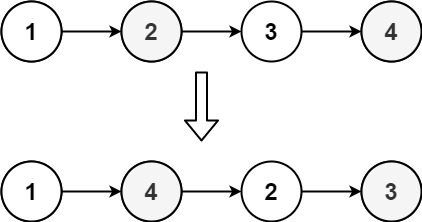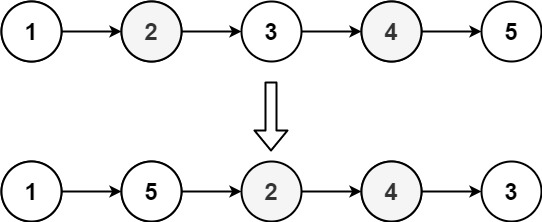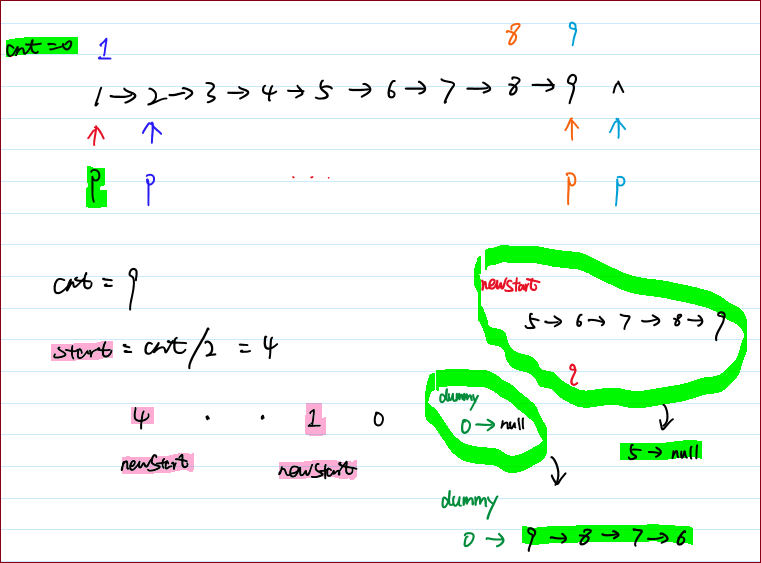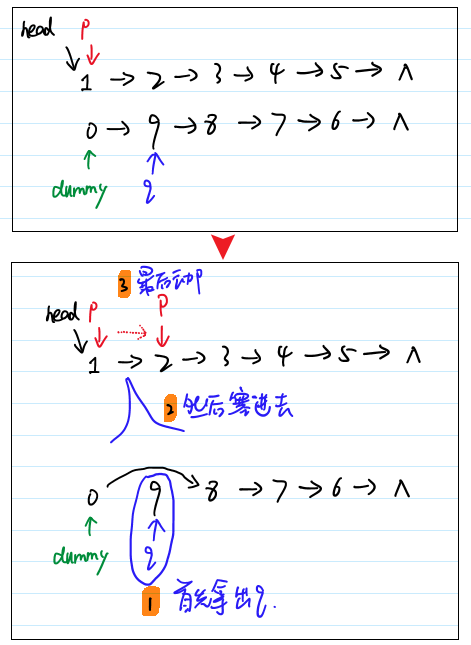[Coding043] LeetCode 143
Reorder List
Get the knowledge flowing and circulating! :)
目录
※ 本题收获
这个程序差点让我放弃编程!
看上去本来很简单,但是思路比较混乱,同时也让我感觉,似乎并不是一天的任何时间都适合编程的,就比如下午15:00左右做这个程序,搞到17:40才把程序的流程理清,到了18:00才最终把文档写完!😓
难点在哪呢?总的来说,还是思路不清。
首先:指针混用,一开始的程序写的时候,有时候用了newStart,有的用了dummy,有的p,有的q,有的r1,有的r2,真是晕头转向。
解法:理清思路再Coding!
然后:思路模糊,一开始用cnt,cnt--(都等于0了)结束了!最后程序我还在用cnt这个为0的变量来辅助衔接链表。
解法:变量前期定义清楚之后,再在后期使用。不要胡乱定义,到处使用。
最后,我想说,不要小看任何一个程序,每个程序都要认真对待。从一开始的时候,就要思路清晰,否则越来越混乱,最后还要重新再理,何苦呢?浪费了时间还消磨了耐心!切记!
这个程序的收获:
从一个链表(5→6→7→8→9→null)挪到另一个链表(dummy→null)的操作【需要明确知道要完成的是什么,如下手绘图中的第一个绿色粗圈】;
两个链表交替衔接的时候,需要清楚地知道从何处断,断了之后又当如何衔接?
line51&line59是一套连招!必须相辅相成,同时存在!
题目:143. Reorder List
You are given the head of a singly linked-list. The list can be represented as:
xxxxxxxxxx11L0 → L1 → … → Ln - 1 → Ln
Reorder the list to be on the following form:
xxxxxxxxxx11L0 → Ln → L1 → Ln - 1 → L2 → Ln - 2 → …
You may not modify the values in the list's nodes. Only nodes themselves may be changed.
Example 1:

xxxxxxxxxx21Input: head = [1,2,3,4]2Output: [1,4,2,3]
Example 2:

xxxxxxxxxx21Input: head = [1,2,3,4,5]2Output: [1,5,2,4,3]
Constraints:
The number of nodes in the list is in the range
[1, 5 * 104].1 <= Node.val <= 1000
代码1(配 · 手绘过程图)
xxxxxxxxxx631/**2 * Definition for singly-linked list.3 * public class ListNode {4 * int val;5 * ListNode next;6 * ListNode() {}7 * ListNode(int val) { this.val = val; }8 * ListNode(int val, ListNode next) { this.val = val; this.next = next; }9 * }10 */11class Solution {12 public void reorderList(ListNode head) {13 ListNode p = head;14 int cnt = 0;15 while (p != null)16 {17 cnt++;18 p = p.next;19 }20
21 int start = cnt / 2;22 23 ListNode newStart = head;24 while (start-- != 0)25 {26 newStart = newStart.next;27 }28
29 // System.out.println(newStart.val);30
31 ListNode dummy = new ListNode(0);32
33 ListNode q = newStart.next;34 while (q != null)35 { 36 // 这一句同时将原链表截断:newStart.next最后会指向链表的尾部(null)37 newStart.next = q.next; // 防止链表断裂38
39 // 此时可以操作q了40 q.next = dummy.next;41 dummy.next = q;42
43 q = newStart.next; // 开始处理新的q44 }45
46 p = head;47 q = dummy.next;48 49 while (q != null) // 把短的插入长的里面50 {51 dummy.next = q.next; // 防止断裂操作152
53 // 把q塞到p的后面,并保证不要断裂54 q.next = p.next;55 p.next = q;56 // 让p继续移动到下一个待处理的地方57 p = q.next;58
59 q = dummy.next; // 防止断裂操作260 }61 return;62 }63}获取链表的两半:

合并链表的两半:

代码解读 | 评价
程序的思路比较简单:
首先把链表分为两半;
方法有很多:
可以用cnt计数,然后cnt/2;
也可以用双指针,一个跑的快,一个跑的慢;跑的快的变为null了,跑的慢的刚好指向中间的那个分割点。
后一半逆序
然后把第一半和最后一半交替接起来。